A Fresh Look & Better MPG For A Familiar Face
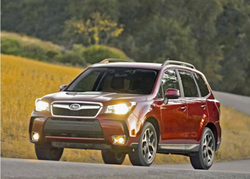
The 2014 Subaru Forester is the first all-new model for this brand since 2009. It is slightly larger than the outgoing edition, looks only a little different but has an unexpected surprise – it’s more fuel efficient.
Like other recently introduced Subarus, the 2014 Forester is helping to erase the automaker’s so-so fuel economy reputation, and earns inclusion in our Clean Fleet Report All-Wheel Drive 30 MPG Club. The mainstream 2.5i model arrives with an EPA estimated 32 mpg highway/24 mpg city and a combined rating of 27 mpg when equipped with a continuous variable transmission (CVT). Choose the manual shifter and fuel economy drops to 29/22 highway/city and 24 combined.
For those willing to forgo some fuel economy in exchange for power, the turbocharged 2.0XT model with a CVT is rated at 28/23 highway/city and 25 combined. That’s also an increase compared to the outgoing model.
New, But Familiar Look
In profile, the new Forester is slightly more sleek for aerodynamics with more fluid body lines and slightly rounded edges, but it won’t be mistaken for any other small crossover SUV. The updated styling is most noticed in the fresh, but still familiar, nose and tail.
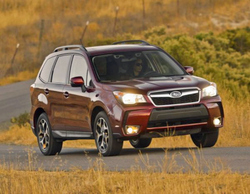
The new sheetmetal reveals little of the Forester’s growth. Sitting on an inch-longer wheelbase, it’s an inch-and-a-half longer overall. It’s also wider and a noteworthy two-and-a-half inches taller.
Interior design carries on in a no nonsense fashion with substance before style. The dashboard presents little design frivolity, though the addition of a center dash-mounted info screen brings things up-to-date. The cabin is comfortable and functional, but materials don’t express the upscale look and feel that Subaru aspires to.
Growing in size always seems to be a good crossover strategy, and the 2014 Forester receives a substantial boost in cabin room. Compact size on the outside, Forester has midsize-class passenger space that has more interior room than better-selling crossovers like the Ford Escape, Honda CR-V, and Toyota RAV4. And, no compact crossover has more cargo volume – 34.4 cubic feet with rear seat backs upright, 74.7 when folded.
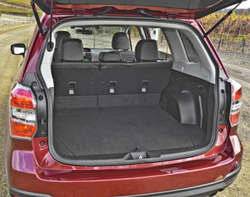
Forester ushered in several new features with this fourth-generation edition. Available is a power liftgate that opens extra tall for loading. When equipped with power-assist, it has a nifty memory opening height function.
Forester also gets Subaru’s EyeSight driver assistance system that integrates adaptive cruise control, pre-collision braking and lane departure warning. EyeSight uses a stereo camera mounted on the inside of the windshield in front of the rearview mirror. It works exceptionally well except when weather conditions, such as heavy rain or snow, obscures the camera’s view.
Familiar Drivetrain
Subaru and Porsche are the only automakers that have faithfully stood by the horizontally opposed boxer engine configuration. Carried over for 2014, a 2.5-liter four-cylinder boxer powers the Forester 2.5i models. It churns out 170 horsepower at 5,800 rpm and 174 pounds-feet of torque at 4,100 rpm.
The 2.5i is one of the few crossovers that still offers a manual transmission, a new six-speed gearbox. Also new is Subaru’s Lineartronic CVT that replaces the outdated four-speed conventional automatic transmission. It features paddle shifters that simulate manual shifting of six gear ratios, and a low shift mode for engine braking when driving down a grade.
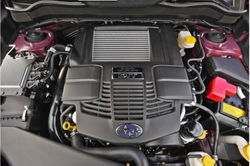
Forester XTs are now powered by a two-liter turbocharged boxer four rather than a 2.5 liter. Utilizing direct injection, the new powerplant not only provides better fuel economy, but improved horsepower and torque. The 250 horsepower eager beaver also employs a CVT with paddle shifters, but one that simulates eight gears.
While Subaru’s four-cylinder boxer engines are proven workhorses, if towing more than 1,500 pounds – par for most four bangers – is on your list, you’ll have to consider V-6 powered crossovers. Of course, you’ll also have to give up fuel economy.
Since it’s a Subaru, bulletproof all-wheel drive is standard for all Foresters. But there’s a new twist with CVT-equipped models called X-Mode. With the push of a button, this low-speed traction system integrates the operation of the engine, transmission, AWD system and brakes to gain traction on uneven terrain and slippery slopes. At low speeds, the system can apportion torque from left to right, enhancing the AWD’s front to rear distribution.
Behind The Steering Wheel, Almost Familiar
Like the previous model, from the driver’s view, the command position is quite good with excellent sightlines. The seat is squarely behind the steering wheel and there’s a clear view of the instrument cluster. Large knobs for the climate system on the center stack are easy to reach and intuitive to use, and the shift lever falls easily to hand.

The big difference is steering. Subaru isn’t alone when it comes to lifeless electric power steering, but the Forester’s new system feels like it was anesthetized. On the plus side, when pushed during cornering, there is little body roll.
I’ve never been a fan of CVTs, but this one is about as good as they get. The engine rarely revved up past actual driving speed, which gives an effect that feels like a clutch slipping. Simulated gear shifting produced smooth up and down shifts with only an occasional hiccup.
Small crossovers are known as “soft roaders” – not designed for off pavement driving other than gravel roads. Subarus are different. We’ve driven every Subaru model on back country trails that one would think were reserved for Jeeps only, and the new Forester is a dandy off roader.
It starts with a Jeep-like ground clearance of 8.7-inches. That’s aided by, not quite Jeep-like, but decent approach, departure and breakover angles.
We spent a couple hours during a sunny Northwest day on a favorite and little-used logging trail. It’s narrow, deeply rutted in places with some steep hills and a couple of switchbacks thrown in. A surprise rockslide made us hesitate, but careful placement of tires brought us up and over some sizeable rocks.
During our week with the Forester 2.5i, we tallied 177.7 miles, 62 of which were on the Interstate. City driving totaled 73 miles and the balance was on two-lane county roads and our off-road excursion. The Forester’s computer measured fuel economy was 31.4 mpg – 4.4 mpg above the EPA combined rating of 27 mpg.
What You Get For The Money
Base price for the Forester 2.5i with manual transmission is $22,820, including $825 destination charges. Choose the CVT and the price jumps a grand to $23,820. Standard features for both include a tilt-and-telescoping steering wheel, height-adjustable driver’s seat, full power accessories, cruise control, four-speaker audio system, Bluetooth connectivity and an iPod/USB audio interface.
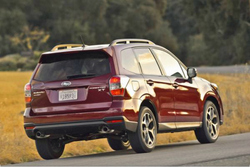
Still has the get-up to go anywhereTo get a rearview camera, now standard on many competitor models, you have to step up to the Premium trim, priced starting at $25,820. It also adds a power driver’s seat, panoramic sunroof and a six-speaker audio system. The Limited trim, at $28,820, adds an All-Weather Package (heated side mirrors and heated front seats), automatic climate control, leather upholstery and power rear liftgate.
Our 2.5i Touring test vehicle included all of the above features plus a navigation system, dual-zone automatic climate control, an eight-speaker audio system, a one-touch control to fold the rear seatback and the auto-close and memory functions for the power liftgate. Optional was the $2,400 EyeSight system that brought the total sticker price to $33,220.
Turbocharged 2.0XT models are priced starting from $28,820 to $33,820.
Forester’s prices are competitive, but technology missing from the feature availability list offered by others in the class are blind spot detection, lane change assist and rear cross traffic alert. Subaru says these will be offered on 2015 models.
By keeping its traditional look, Forester may not be the most stylish compact crossover, but it’s difficult to beat its tried and true AWD system with the new X-Mode, pleasant road manners, spacious passenger cabin and class-leading cargo room. And then there’s that fuel economy thing.
Competitors
Photos by the manufacturer
Published March 9, 2014
Other related stories that might be of interest:
Road Test: 2013 Ford Escape
Road Test: 2013 Honda CR-V
Road Test: 2014 Toyota RAV4
Test Drive: 2013 Subaru XV Crosstrek

7 thoughts on “Road Test: 2014 Subaru Forester”